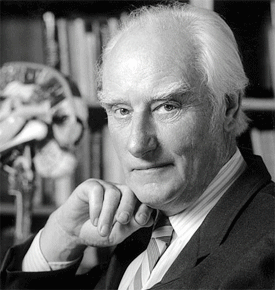Francis Crick
Francis Crick was born in 1916. He was a neuroscientist, physicist
and molecular biologist from Great Britain, who also lived for
a time in California.
 Francis Crick
Francis Crick |
|
His name is most known for his link with James D. Watson, in
the discovery of DNA molecules structure, which was in 1953. In
1962, Watson, Crick and Maurice Wilkins would be given the Nobel
Prize for Physiology or Medicine, thanks to their discoveries
regarding nucleic acids' molecular structure. Crick was integral
to research that revealed genetic codes, and the discovery of
the one way flow of cells from DNA on to RNA and then to protein.
Francis Crick was raised in England, and he was interested in
science from a young age. With help from Maurice Wilkins and Rosalind
Franklin, he won acceptance into Cambridge University. He worked
with physics until a World War II bomb destroyed his laboratory
and equipment. During the war, he also worked with acoustic and
magnetic mines, and helped to design a newer mine that worked
well against German-made minesweepers.
After the war ended, Crick studied biology, along with other
physical scientists. He felt that it was an adjustment for him,
going from what he called the deep simplicity and elegance of
physics to what he described as the more elaborate mechanisms
evolved from natural selection over many billions of years.
Crick worked with cytoplasm properties until he left for Cambridge's
Cavendish Laboratory. He was especially interested in unsolved
issues of biology. Specifically, he worked to learn more about
the way molecules transitioned from non-living into living. He
felt that Darwin's evolution theory and Gregor Mendel's knowledge
of molecular genetics could be combined, to reveal the real secret
of life.
Crick and James Watson shared interests in learning about how
genetic information could be stored in a molecular form. Crick
also wrote his PhD thesis, and was frustrated that Rosalind Franklin
and Maurice Wilkins' had failed to cooperate in finding a DNA
molecular model. He and Watson made another attempt to find that
DNA model. They used images of X-ray diffraction in their progress
report that was written for King's College laboratory.
Crick made some attempts to experiment with nucleotide base pairing,
but he was not so much an experimental biologist as he was theoretically
inclined. He thought about the interactions between each base.
The DNA model that Watson and Crick built in 1953 would be constructed
again in 1973, and then donated to London's National Science Museum.
Crick moved from Cambridge University to California in 1976,
and worked in X-ray diffraction collaborations including one with
Alexander Rich that pursued the exact structure of collagen. From
then until his death in 2004, he was a Distinguished Research
Professor at Salk Institute for Biological Studies, located in
La Jolla, California. His last research topics had to do with
theoretical neurobiology, as well as advancing the study of the
consciousness of humans. He would stay at this post until he died,
and he was working on a manuscript when he passed away.
Rumor Has It …
Rumor has it that Francis Crick once had a daughter who he affectionately
called Cricket. And ironically enough while in Great Britain Cricket
played Cricket much to the delight of Crick.
Written by Kevin Lepton
|

